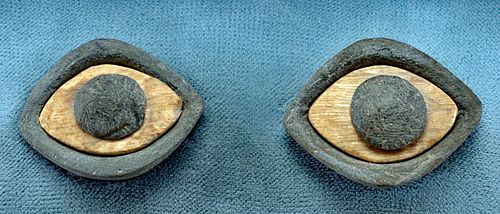Mesopotamian Lapis Lazuli, Stone, & Bone Eyes
Lot 17
About Seller
Artemis Fine Arts
686 S Taylor Ave, Ste 106
Louisville, CO 80027
United States
Selling antiquities, ancient and ethnographic art online since 1993, Artemis Gallery specializes in Classical Antiquities (Egyptian, Greek, Roman, Near Eastern), Asian, Pre-Columbian, African / Tribal / Oceanographic art. Our extensive inventory includes pottery, stone, metal, wood, glass and textil...Read more
Categories
Estimate:
$1,500 - $2,250
Absentee vs Live bid
Two ways to bid:
- Leave a max absentee bid and the platform will bid on your behalf up to your maximum bid during the live auction.
- Bid live during the auction and your bids will be submitted real-time to the auctioneer.
Bid Increments
| Price | Bid Increment |
|---|---|
| $0 | $25 |
| $300 | $50 |
| $1,000 | $100 |
| $2,000 | $250 |
| $5,000 | $500 |
| $10,000 | $1,000 |
| $20,000 | $2,500 |
| $50,000 | $5,000 |
| $100,000 | $10,000 |
| $200,000 | $20,000 |
About Auction
By Artemis Fine Arts
Dec 2, 2021
Set Reminder
2021-12-02 10:00:00
2021-12-02 10:00:00
America/New_York
Bidsquare
Bidsquare : Fine Antiquities | Asian | Ethnographic Art
https://www.bidsquare.com/auctions/artemis-gallery/fine-antiquities-asian-ethnographic-art-7918
Features classical antiquities, ancient and ethnographic art from cultures encompassing the globe. Egyptian, Greek, Roman, Etruscan, Near Eastern, Asian, Pre-Columbian, Native American, African / Tribal, Oceanic, Spanish Colonial, Russian, Fine / Visual Arts, so much more! Artemis Fine Arts info@artemisfinearts.com
Features classical antiquities, ancient and ethnographic art from cultures encompassing the globe. Egyptian, Greek, Roman, Etruscan, Near Eastern, Asian, Pre-Columbian, Native American, African / Tribal, Oceanic, Spanish Colonial, Russian, Fine / Visual Arts, so much more! Artemis Fine Arts info@artemisfinearts.com
- Lot Description
Ancient Near East, Mesopotamia, ca. 2900 to 2250 BCE. A haunting pair of eyes boasting white sclerae hand-carved from the bone of an ungulate with inlays of black stone pegs forming the pupils. Each are encased on their sides and verso by a lapis lazuli stone of vibrant blue that has been hollowed out, forming eyelids. These would have been inlaid into a composite figure. As seeing was a major channel of communication with gods, eye inlays such as these may have been used in the composite figure of a worshipper to express the figure's admiration for a god and accentuate the awe-inspiring nature of that god. Enlarged eyes were also a conventional means of warding off evil in Mesopotamia, known today as an apotropaic device. Size of eyes (both about the same): 1.3" L x 0.9" W x 1" H (3.3 cm x 2.3 cm x 2.5 cm); (case): 4.8" L x 2.5" W x 1.7" H (12.2 cm x 6.4 cm x 4.3 cm)
Cf. The Metropolitan Museum of Art, accession number 62.70.84. A slightly larger Mesopotamian eye inlay made completely of stone was sold for $35,000 at Christie's New York as lot 78 in the "Antiquities" auction of June 4th, 2008 (live auction 2007).
Provenance: East Coast collection, New York Gallery, New York City, New York, USA, acquired before 2010
All items legal to buy/sell under U.S. Statute covering cultural patrimony Code 2600, CHAPTER 14, and are guaranteed to be as described or your money back.
A Certificate of Authenticity will accompany all winning bids.
PLEASE NOTE: Due to recent increases of shipments being seized by Australian & German customs (even for items with pre-UNESCO provenance), we will no longer ship most antiquities and ancient Chinese art to Australia & Germany. For categories of items that are acceptable to ship to Australia or Germany, please contact us directly or work with your local customs brokerage firm.
Display stands not described as included/custom in the item description are for photography purposes only and will not be included with the item upon shipping.
#144211Expected surface wear with some light abrasions commensurate with age. Otherwise, intact and excellent with rich earthen deposits. Accompanied by a rectangular, blue, leather case.Condition
- Shipping Info
-
All shipping is handled in-house for your convenience. Your invoice from Artemis Gallery will include shipping calculation instructions. If in doubt, please inquire BEFORE bidding for estimated shipping costs for individual items.
-
- Buyer's Premium



 EUR
EUR CAD
CAD AUD
AUD GBP
GBP MXN
MXN HKD
HKD CNY
CNY MYR
MYR SEK
SEK SGD
SGD CHF
CHF THB
THB














